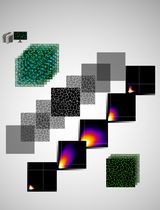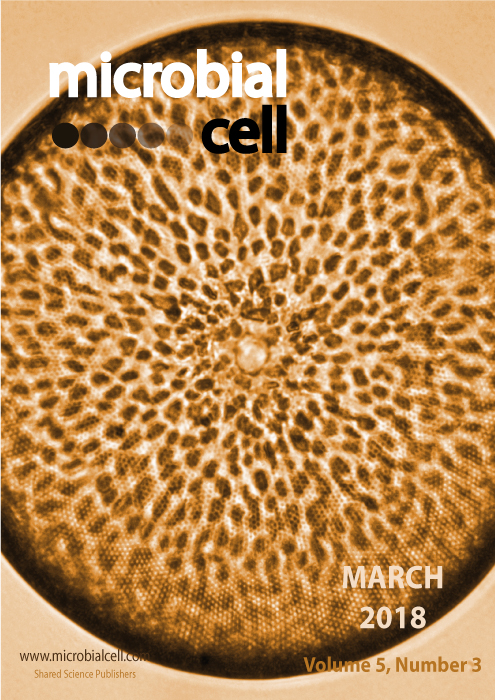- EN - English
- CN - 中文
Leishmania Parasite Quantification by Bioluminescence in Murine Models
在小鼠模型中利用生物发光进行利什曼原虫的定量分析
发布: 2019年11月20日第9卷第22期 DOI: 10.21769/BioProtoc.3431 浏览次数: 4532
评审: Alexandros AlexandratosMahmoud Kamal AhmadiOlga Koutsoni

相关实验方案

基于Fiji ImageJ的全自动化流程开发:批量分析共聚焦图像数据并量化蛋白共定位的Manders系数
Vikram Aditya [...] Wei Yue
2025年04月05日 2543 阅读
Abstract
Leishmaniasis remains a major public health problem worldwide with a prevalence of 12 million, an incidence of 1 million persons, and 350 million people being at risk. Murine models have been largely used for studying the host-pathogen relationship and developing effective chemotherapies against Leishmania parasites. Thus, preclinical imaging is crucial for monitoring the disease outcome. The aim of this protocol is to quantify parasite burden using bioluminescence in vivo imaging. Here, we describe a high-throughput imaging workflow, together with data acquisition and analysis ideal to assess in vivo parasite load in mouse models.
Keywords: Parasite (寄生虫)Background
Leishmania parasites are the causative agents of the neglected tropical disease known as leishmaniasis. The disease outcome varies depending on different factors including the infecting species, the immune response of the host, the presence of an endosymbiotic virus within Leishmania parasites (Ives et al., 2011), or the co-infection with viruses such human immunodeficiency virus (HIV) or lymphocytic choriomeningitis mammarenavirus (LCMV) which can be detrimental for disease exacerbation (van Griensven et al., 2014; Rossi et al., 2017). Therefore, the study of parasite persistence using murine models has emerged in the past years (Eren et al., 2016). The quantification of parasite burden in experimental models of Leishmania infection has been commonly quantified by either Real-Time Quantitative Reverse Transcription PCR (qRT-PCR) or by limiting dilution assays upon euthanasia of animals (Hartley et al., 2016). In this protocol, we report a non-invasive technique for the quantification of parasite burden during the disease progression using luciferase expressing parasites (Ives et al., 2011; Hartley et al., 2018). Moreover, this approach can also be applied for the in vivo detection of other chemiluminescent agents such as luminol that is used as a readout of myeloperoxidase (MPO) activity in acute and chronic inflammatory diseases, or for any other organism expressing luciferase.
Materials and Reagents
- Eco Nitrile PF 250 Gloves (ecoSHIELDTM)
- Tissue culture flask 25 version “Vent” (TPP®, catalog number: 90025)
- Microcentrifuge 1.5 ml tubes (Corning, Axygen®, catalog number: MCT-175-C)
- 50 ml syringe (B. Braun Medical, catalog number: 4617509F-02)
- Polypropylene conical 15 ml centrifuge tube (TPP Techno Plastic Products, catalog number: 91015)
- Polypropylene conical 50 ml centrifuge tube (TPP Techno Plastic Products, catalog number: 91050)
- BD Micro-FineTM + U-100 Insulin syringes 0.5 ml 0.33 mm (29G) x 12.7 mm (BD Medical, catalog number: 324824)
- 2 ml serological pipettes (FALCON®, catalog number: 357507)
- 10 ml serological pipettes (SARSTEDT, catalog number: 86.1254. 001)
- 25 ml serological pipettes (SARSTEDT, catalog number: 86.1685.001
- 0.22 μm syringe-filter (Carl Roth, catalog number: P668.1)
- Vacuum Filtration 500 “rapid”-Filtermax, PES membrane 0.22 μm pore size (TPP®, catalog number: 99500)
- 6-9-week-old specific-pathogen free C57BL/6 female mic
- Dulbecco's Phosphate-Buffered Saline (DPBS) (Thermo Fisher Scientific, GibcoTM, catalog number: 14040091), stored at 4 °C
- Schneider’s Drosophila Medium w: L-Glutamine and 0.40 g/L NaHCO3 (PANTM BIOTECH, catalog number: P04-91500), store at 4 °C
- Fetal Bovine Serum (FBS) (Thermo Fisher Scientific, GibcoTM, catalog number: 10270106), stored at -20 °C
- HEPES Buffer (1M) (BioConcept, catalog Number: 5-31F00-H), stored at 4 °C
- Penicillin-Streptomycin (P/S) solution (10.000 IU/ml P/ 10 mg/ml S) (Bioconcept, catalog number: 4-01F00-H), stored at 4 °C
- Hemin BioXtra, from Porcine (Sigma-Aldrich, catalog number: 51280), stored at 4 °C
- Folic acid (FlukaTM, catalog number: 47620), stored at 4 °C
- 6-Biopterin (Sigma-Aldrich, catalog number: B2517), stored at -20 °C
- Dimethyl sulfoxide (DMSO) Cell culture grade (AppliChem GmbH, catalog number: A3672)
- Sodium hydroxide ≥ 98% p.a., ISO, in pellets (Carl Roth, catalog number: 6771.1)
- Glutaraldehyde solution technical, ~50% in H2O (5.6 M) (FlukaTM, catalog number: 49629), stored at 4 °C
- 70% Ethanol F25® (in H2O) (Alcosuisse)
- VivoGloTM Luciferin, in vivo Grade (Promega, catalog number: P1041), stored at -20 °C
- Luciferase-expressing transfectants of Leishmania guyanensis parasites M4147 (MHOM/BR/75/M4147)
- AttaneTM Isoflurane ad us. vet. (Provet AG, catalog number: covetrus 722 2222)
- Complete parasite culture medium (see Recipes), stored at 4 °C
- Heat-inactivated FBS (see Recipes)
- Biopterin (see Recipes)
- Hemin-folate (see Recipes)
- Parasite fixative solution (see Recipes), stored at 4 °C
- Luciferin solution (see Recipes), stored at -20 °C
Equipment
- FormaTM Steri-CycleTM CO2 Incubator at 26 °C (Thermo Fisher Scientific, catalog number: 371)
- Pipette controller (INTEGRA, catalog number: 155017)
- Pipettes (Gilson®)
- Counting chamber improved Neubauer (Assistent®, catalog number: 40442)
- Centrifuge 5810 R (Eppendorf)
- Benchtop pH Meter (METTLER TOLEDO)
- Water Bath (Julabo)
- Laminar flow hood parasite culture (SafeFAST Premium)
- Laminar flow hood mouse handling (Scanlaf Safe 1200)
- Combi-vet Anesthesia machine with 4 Flowmeters (Rothacher Medical GmbH)
- O2 Concentrator MIC 02 10 lpm for Anesthesia system (Rothacher Medical GmbH, catalog number: CV 10-101 MIC 10 lpm)
- Anesthetic waste gas filter (Aldasorber 1400g)
- Veterinary Anesthesia Induction chamber/for rodents (Rothacher Medical GmbH, catalog number: PS-0346)
- In vivo Imaging System (In-Vivo Xtreme II, BRUKER)
- In-Vivo XtremeTM II SPF animal chamber (SPFC) with HEPA filters (BRUKER)
- Inverted microscope (Olympus CKX41)
- Inverted confocal microscope (Zeiss LSM 800)
- Computer (Windows 7)
Software
- Molecular Imaging (MI) software version v. 7.5.3.22464 (BRUKER)
- GraphPad Prism software version 8.1.0 (GraphPad)
Procedure
文章信息
版权信息
© 2019 The Authors; exclusive licensee Bio-protocol LLC.
如何引用
Reverte, M. and Fasel, N. (2019). Leishmania Parasite Quantification by Bioluminescence in Murine Models. Bio-protocol 9(22): e3431. DOI: 10.21769/BioProtoc.3431.
分类
微生物学 > 病原体检测 > 生物发光
细胞生物学 > 细胞成像 > 共聚焦显微镜
您对这篇实验方法有问题吗?
在此处发布您的问题,我们将邀请本文作者来回答。同时,我们会将您的问题发布到Bio-protocol Exchange,以便寻求社区成员的帮助。
提问指南
+ 问题描述
写下详细的问题描述,包括所有有助于他人回答您问题的信息(例如实验过程、条件和相关图像等)。
Share
Bluesky
X
Copy link










